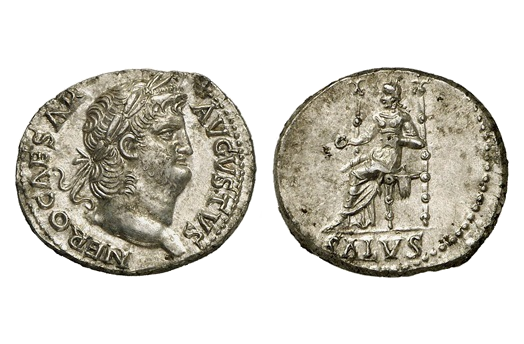
about ancient nomos
Ancient Nomos Art is a museum of galleries exhibiting ancient coins and ancient mint maps. The coin gallery displays the diverse art and history of hand-crafted ancient Greek, Roman, Byzantine, Persian and Medieval coinage. The ancient mints mapping gallery features Greek, Roman, Byzantine, Asia Minor and Medieval mint city regions and territories. Visitor's are welcome to explore, study and enjoy Ancient Nomos Art.

Imperial, Roman – 66 AD
Emperor Nero
From Ancient Galleries

Obverse: Laureate bust of Emperor Nero facing right while wearing a very subtle beard.
Reverse: Salus draped and seated left on an ornamented throne and holds a patera.
LEGEND
Obv: NERO CAESAR AVGVSTVS, Laureate bust of Nero facing right while wearing a very subtle beard. Rev: Goddess Salus, draped and seated left on an ornamented throne. She wears earrings with hair in braids over the left shoulder and is holding a patera in the right hand while resting the left hand on her side; SALVS legend in exergue below.
The exceptional Nero denarius above is a fascinating coin on many levels, possessing an enduring interest, quality and style like few other Roman issues. On one level, the above example is a wonderful testament to the ancient Roman engravers, those masterful die cutting artisans of ancient Rome, whose technical ability, dexterity and artful craft was able to capture the very personality traits and facial physiognomy of this infamous ruler. At another level, the coin is a textual and figural artifact representing Roman imperial power. A power that offered the Roman emperor an opportunity to communicate overtly political statements and clever personal messages. Finally, this specimen exemplifies how the nature of Roman propaganda and imperial doctrine went hand in hand with the empires financial goals and monetary system. To begin, the above coins design and creation began in early 65 AD, a time when Nero’s obverse portraits and reverse images began taking on dramatic physical and political changes. Most notably, the coins obverse bust started to depict Emperor Nero with a very subtle beard and with a unique hairstyle. Also, the engravers were also keenly able to add slightly larger features to his chins, cheeks and neck, giving Nero’s portrait a somewhat portly facial appearance. This is perhaps the most classic or idealized image of Nero so many can readily recognize. Many historians wonder why Nero choose to appear bearded at this time. Especially since, prior to this issue, Nero was always clean shaven and more lean. According to Cassius Dio, Nero had first shaved his beard in 59 AD, but the beard only appears on coins of 65-66 AD. Some believe his beard is a symbolic reference to his Claudian ancestry, while others think this was his actual appearance during the Pisonian Conspiracy. Other portrait changes to this coin include Nero’s unmistakable and well groomed hairstyle. He is known to have admired the “coma in gradus formata” or formed curl hairstyles worn by contemporary Roman actors and charioteers, according to Suetonius. Some scholars believe Nero’s hairstyle is an idealistic image influenced by his love and admiration of the ancient Hellenistic Greek styles. Such Greek influences can also be seen in the slightly upward tilt of his head and the deeply set eyes in furrowed brows, a characteristic Hellenistic influence. He is now seen with a more portly face, noticeably his neck, cheek and chin. Are the engravers attempting to personify Nero as a man prone to indulgence, satiated and well-fed? Many myths about his unrestrained attitudes and behavior abound. In addition to his coin imagery, one must mention the nature of propaganda going hand in hand with Nero’s control over the Roman financial and monetary system. To understand his two-fold use of propaganda, we look to the coins reverse image and Latin legend. Firstly, the seated woman is the Goddess Salus, an image known by ancient Roman’s as the goddess of health and prosperity. The image of Salus also coincides with the commemorations taking place for the building of a new temple to Salus. Ancient polytheist Romans would often pray to the sympathetic goddess Salus for their personal well-being, thus this reverse image creates an association between the health of Nero and health of the state. Secondly, Nero believed Salus was his personal redeemer, salvation and protector following the Pisonian Conspiracy, imagining the failed conspiracy and assassination attempt on his life could only have been achieved through the divine intervention of Salus. Many ancient coin collectors believe the Roman Empire reached the peak of numismatic art and expression with the very insightful portrait engravings of this emperor’s unique and complex persona.
DOCUMENTATION
Value: Denarius. Metal: AR Silver. Weight: 3.39 grams. Mint: Rome. Date: 65-66 AD.
Attribution: Roman Imperial Coinage I 60; RSC 314; BMCRE 90-3; BN 228; Mac Dowall, Nero 59.
Legend, Documentation and Attribution
